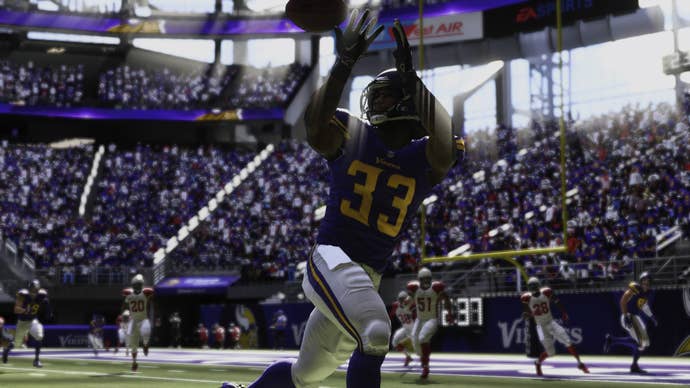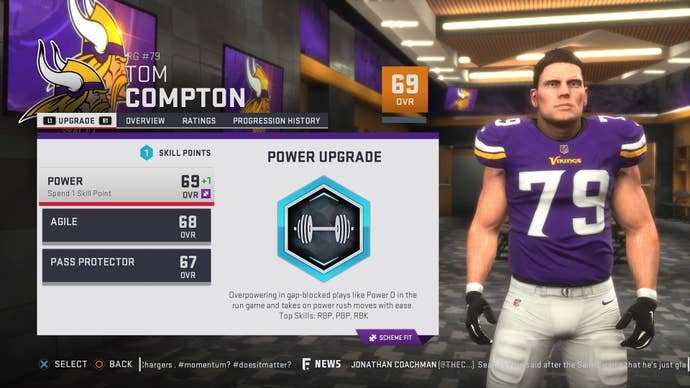Madden 19 Review
A brand new season is upon us. Our full review.
This article first appeared on USgamer, a partner publication of VG247. Some content, such as this article, has been migrated to VG247 for posterity after USgamer's closure - but it has not been edited or further vetted by the VG247 team.
It's never easy following up on a massive update to a sports sim like Madden. Even the smartest upgrades will invariably pale in comparison to the excitement of, say, a new story mode or a new engine. That's the challenge facing Madden 19 heading into this year's review.
Coming off last year's entry, which saw the series shift to the Frostbite Engine and introduce the story-driven Longshot, Madden 19 is necessarily a year of refinement. It spends many of its resources on subtle but necessary updates to the animation, which primarily impacts the running game, and needed upgrades to franchise mode. At first blush it doesn't look terribly different from last year's entry, but there's a fair amount going on beneath the surface.
The more I've played, the more I've come to appreciate the nuances of this year's update. Throwing to the flats is now much less likely to carry you straight out of bounds thanks to new cutting mechanics. Jukes are much more fluid and realistic, and it's easier to push the pile forward with a power runner. Hits feel powerful without being ridiculous.
Subtle improvements like these are evident throughout the entire package, from Madden Ultimate Team to franchise mode. The downside is that this year's version is also somewhat less polished than usual. The new celebrations, which are meant to capture last year's wave of creatively coordinated routines, are prone to weird interactions as players bump into one another trying to get into position to dance. Franchise mode's new gallery system, an admittedly very cool feature, only seems to work half the time. There are odd detection issues with catching a touchdown in the back of the endzone. In all, Madden 19 offers some vital improvements, but occasionally struggles to match the oomph of last year's update. And nowhere is that more apparent than Longshot.
Longshot Returns for an Encore
Ambition was the watchword of Longshot when it debuted last year. It matched a fun tale of breaking into the NFL with lots of interesting choices, challenges, and unique outcomes. Its conclusion heavily suggested that those outcomes would carry into Madden 19 as it continued the story of Colt Cruise and Devin Wade.
But Longshot: Homecoming entirely dispenses with the choices made in the first game, instead opting to jump ahead a year and effectively start from zero. It finds Devin Wade struggling to break in with the Dallas Cowboys (as opposed to whatever team you chose in Longshot), and Colt Cruise out of football entirely. Their stories run concurrently, with Wade trying to win a spot with the Cowboys in preseason, and Cruise dealing with family and the realities of his hometown.
Wade has his part to play, but Cruise is undoubtedly the star of the story. He does the bulk of the emotional heavy lifting while Wade, who has seemingly learned nothing from his time on Longshot, bumbles his way through training camp. Eventually the story more or less forgets Wade entirely as it builds to its climax.
"Football is Family" is the mantra of this year's tale. It's the same phrase used by the NFL for its ad campaign, making it feel more than a little like a sepia-toned extension of the league's marketing arm (granted, that's what Madden ultimately is: marketing). It paints an idealized picture of small town Texas, one where high school football forms the basis for the entire community, where all that's needed to revitalize the school is a really big football stadium. It's Friday Night Lights without the often brutal social commentary, which Madden was never equipped to handle in the first place.
Compared to the first edition of Longshot, which included a variety of drills and dialogue choices meant to teach you about football as a whole, Homecoming feels very simple. Most of the gameplay sections are built around driving down the field and scoring, removing some of the variety from last year's challenges. The upside is that the wonderful high school backdrops, which are so evocative of Friday Night Lights and the old NCAA Football games, are back. I know I just spent a paragraph complaining about Longshot's uncritical lionization of high school football, but I won't deny that I love the detail of the stadium, the fans in the bleachers, and the redneck commentators. It's one thing that Longshot has consistently gotten right.
The story ends on what feels like a note of finality, even featuring Animal House-like epilogues for every character. It's a disappointing follow-up to the very promising first entry, ultimately falling back on the cliches that the original worked so hard to avoid. It lacks any kind of meaningful choices, its challenges are more straightforward and less interesting, and it telegraphs most of its dramatic twists. The feeling I get is that the team had something considerably more ambitious in mind for the second game, but ultimately couldn't make it work.
Still, even if Longshot: Homecoming doesn't live up to the first entry, I hope this isn't the end of story mode in Madden. It makes for a clever tutorial, it expands the scope beyond the NFL, and it has likable protagonists in Colt and Devin. It also serves to liven up Ultimate Team and Franchise Mode with importable characters, stadiums, and coaches, challenging you to unlock as many as you can. Madden's first foray into storytelling is only partially successful, but fingers crossed that this is the beginning rather than the end of the franchise's experimentation with narrative design.
Madden 19 Focuses on the Hardcore Fans
Outside of Longshot and the new animation system, Madden 19's biggest update is to franchise mode (and perhaps the fact that it's on PC now). It gets a nice facelift in this version, introducing a number of neat new features designed to extend its long-term appeal.
It notably overhauls the XP gain system from previous versions, which was outdated and badly in need of a rethink. Now, instead of manually upgrading stats from a pool of points for every single character, you choose from a handful of archetypes that automatically allocate points into different stats. This approach isn't as flexible, but it solves a multitude of problems: It removes the unrealistic min-maxing of previous versions, it cuts out some of the confusion engendered by the more arcane stats, and above all, it's less tedious. So much less tedious.

I was initially more skeptical of the updates to schemes, a system meant to mimic the strategy of football, but I've since come around to them. Schemes have been in Madden for several years now, but they've long felt superfluous, mainly impacting free agency. The updated mechanic ties into the aforementioned archetypes, boosting XP depending on whether players fit in with their coach. I find that they make it easier to scout for the draft, as you naturally gravitate toward players who fit into the scheme you've chosen. Schemes on the whole don't mean much in terms of practical gameplay—they're a shorthand way for helping you to understand how a player should be used—but they feel more visible and less superfluous than before.
These improvements bolster an already solid mode, which isn't quite as fully-featured as NHL or NBA 2K, nor as realistic as MLB The Show, but is by far the most streamlined and accessible of the bunch. I remain a big fan of Play the Moments—Madden's simming engine that automatically drops you into high leverage plays. It adds a pleasing degree of uncertainty, ensuring that I have to actually work to beat the CPU while keeping games manageably short. On top of that, Madden is one of the last sports games to include the ability to create an online league, which I hope never goes away.
The rest of Madden 19's updates are a grab bag of improvements across multiple modes. Custom draft classes that can be downloaded from Madden's shared server are a cool way to get your favorite legends in franchise mode. Madden Ultimate Team streamlines the player upgrades from last year while introducing Solo Battles, which lets you play against CPU-controlled versions of actual MUT teams to climb a leaderboard and win rewards—a nice alternative to the monotonous grind of the solo challenges. MUT Squads now allows you to play against the CPU, making it a nice way to relax and play co-op with your friends (it's just a pity that it's locked behind Ultimate Team).

Madden has been defined by its steady and intelligent improvements over the past few years, and Madden 19 is more of the same. Contrary to the general perception of the series, Madden is a consistently solid football sim that has made some major strides this generation. Its improvement has been driven by a smart roadmap rather than the marketing-driven leaps of the past.
Nevertheless, it's hard to point to any one element of Madden 19 and call it a definitive selling point. The animation improvements are noticeable, but not so much so that they fundamentally change the game, and they bring with them some ragged player interactions. The franchise mode improvements are great, but owner mode remains a sore point. The biggest, most interesting update to Madden 19—Longshot: Homecoming—is also the most disappointing part of the game. And hardcore fans will notice niggling details, like the lack of run-pass option plays.
It all adds up to an entry that is decidedly geared toward the hardcore, with the sort of additions that they are most prone to notice. Consider it a first down with some distance to go before another score.
ConclusionMadden 19 is a solid, if occasionally ragged, follow-up to last year's big transition to Frostbite. The improvements to the animation and franchise mode stand out, but Longshot: Homecoming feels like a step back from last year's ambitious introduction. The multitude of interesting but mostly subtle updates ultimately make this an entry that is primarily geared toward hardcore fans of the series.



